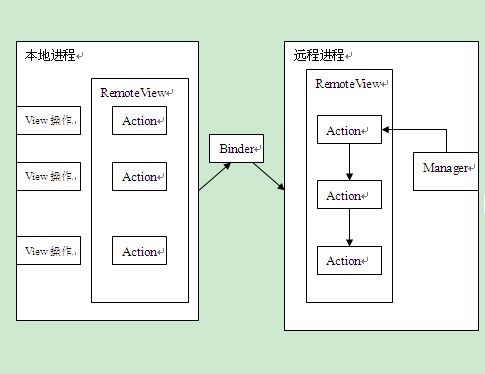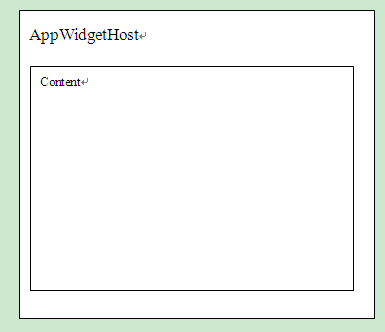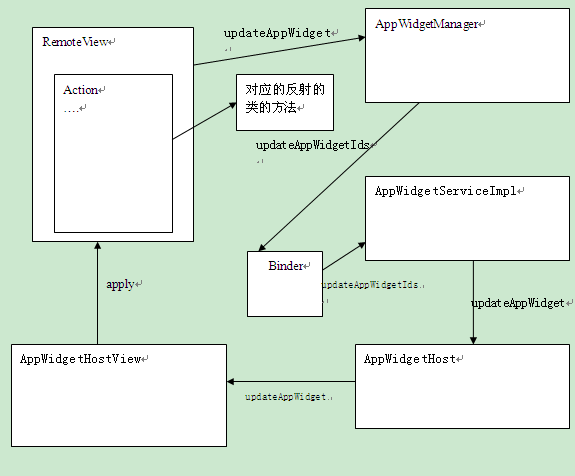前言
由于公司环境恶劣,小菜鸟我本来想画UML图来显示类与类之间的关系,可惜这个念头无法达成,也只好用Word文档来完成。待菜鸟我辞职了,再自己画上UML图和Gif动态图,来显示类于类之间的关系。所以如果有看客请谅解谅解本人的情况。
正文
之前复习了实现桌面小部件的时候,知道了其中运用到了RemoteView这个特殊的类。这个类,顾名思义就是远程视图。可以跨越进程的显示View。
这也就诞生了一些特殊应用,比如说,我们完成远程的显示视图。之前复习的AIDL也可以办到这一点,但是相比于直接使用RemoteView来说的确是复杂了那么一点。
不过RemoteView的缺点也是很明显的,为了提高RemoteView的进程间通讯的速度,RemoteView只支持一下几种View以及 ViewGroup:
- Layout:
FrameLayout,LinearLayout,RelativeLayout,GridLayout - View:
AnalogClock,Button,Chronometer,ImageButton,ImageView,ProgressBar
,TextView,ViewFlipper,ListView,GridView,StackView,AdapterViewFilter,
ViewStub。
RemoteView在系统中主要运用的场景有:通知和桌面部件。之前对通知有了一定的研究了,这一次我们来分析桌面部件中RemoteView的应用。
首先,上一章我们提到了,在传输RemoteView之前,需要现在RemoteView中设置好相关的资源:
RemoteViews remoteView = new RemoteViews(context.getPackageName(),R.layout.appwidget);
remoteView.setImageViewBitmap(R.id.imageView1,rotateBitmap(context,srcBitmap,degree));那么我们就从方法setImageViewBitmap作为研究入口开始探索。
public void setImageViewBitmap(int viewId, Bitmap bitmap) {
setBitmap(viewId, "setImageBitmap", bitmap);
}这里很简单又调用了setBitmap
public void setBitmap(int viewId, String methodName, Bitmap value) {
addAction(new BitmapReflectionAction(viewId, methodName, value));
}接着这里又调用了addAction的方法。在这里我先提一提RemoteView的工作原理,这样才好继续理解。
前文提到了,RemoteView同样可以向AIDL实现那样用View去访问远程进程,但是原理却完全不一样。AIDL是通过另一端实现.Stub内部类,在其中调用远程View数据来实现。
然而在RemoteView中,使用的策略是将实现了Parcelable接口的内部类Action传送到远程进程。
private abstract static class Action implements Parcelable我们将操作的对象操作封装到Action中,接着在远程端依次操作Action,最后再一次跨进程回到RemoteView中让RemoteView去修改View。这么做的高明之处在于,省去了每一种View定义一个Binder接口,提高了程序的性能。
RemoteView中的set工作
了解RemoteView的原理之后,让我们看看addAction是如何实现的。
private void addAction(Action a) {
if (hasLandscapeAndPortraitLayouts()) {
throw new RuntimeException("RemoteViews specifying separate landscape and portrait" +
" layouts cannot be modified. Instead, fully configure the landscape and" +
" portrait layouts individually before constructing the combined layout.");
}
if (mActions == null) {
mActions = new ArrayList<Action>();
}
mActions.add(a);
// update the memory usage stats
a.updateMemoryUsageEstimate(mMemoryUsageCounter);
}
从上面的源码,可以清晰的知道,addAction是将一系列Action封装到List中,这里就完成了Action的存储。
我们什么时候调用这里面的Action的list呢?我们之前写AppWidget接下来是这么写:
AppWidgetManager appWidgetManager = AppWidgetManager.getInstance(context);
appWidgetManager.updateAppWidget(new ComponentName(context, AppProvider.class),remoteView);这么写其实就是AppWidgetManager调用AppWidgetProvider中的我们自己覆写的onUpdate()方法。
比如说,我们研究的setBitmap方法中,传入了方法名setImageBitmap,接着在addAction中通过反射调用这个方法。
且看在BitmapReflectionAction这个内部类中的构造类。
BitmapReflectionAction(int viewId, String methodName, Bitmap bitmap) {
this.bitmap = bitmap;
this.viewId = viewId;
this.methodName = methodName;
bitmapId = mBitmapCache.getBitmapId(bitmap);
}可以知道的,这里将相关的数据全部存入到这个继承了Action类的BitmapReflectionAction。
AppWidgetManager工作
下面是AppWidgetManager的updateAppWidget方法。
public void updateAppWidget(int[] appWidgetIds, RemoteViews views) {
if (mService == null) {
return;
}
try {
mService.updateAppWidgetIds(mPackageName, appWidgetIds, views);
}
catch (RemoteException e) {
throw new RuntimeException("system server dead?", e);
}
}这里的AppWidgetManager将会在SystemServer中运行起来,这里并不讨论,先放出一点证据:
private static final String APPWIDGET_SERVICE_CLASS ="com.android.server.appwidget.AppWidgetService";
if (mPackageManager.hasSystemFeature(PackageManager.FEATURE_APP_WIDGETS)) {
mSystemServiceManager.startService(APPWIDGET_SERVICE_CLASS);
}上面那个SystemServer究竟如何启动这里暂不做讨论,我们继续。
在上面一段函数中mService同样调用了 updateAppWidget,但是在这里指的是IAppWidgetService这个Binder接口。而AppWidgetServiceImpl就是实现这个接口。
class AppWidgetServiceImpl extends IAppWidgetService.Stub implements WidgetBackupProvider,OnCrossProfileWidgetProvidersChangeListener
AppWidgetServiceImpl中工作
我们看看这个类中updateAppWidget中调用了updateAppWidgetIds:
private void updateAppWidgetIds(String callingPackage, int[] appWidgetIds,
RemoteViews views, boolean partially) {
final int userId = UserHandle.getCallingUserId();
if (appWidgetIds == null || appWidgetIds.length == 0) {
return;
}
// Make sure the package runs under the caller uid.
mSecurityPolicy.enforceCallFromPackage(callingPackage);
final int bitmapMemoryUsage = (views != null) ? views.estimateMemoryUsage() : 0;
if (bitmapMemoryUsage > mMaxWidgetBitmapMemory) {
throw new IllegalArgumentException("RemoteViews for widget update exceeds"
+ " maximum bitmap memory usage (used: " + bitmapMemoryUsage
+ ", max: " + mMaxWidgetBitmapMemory + ")");
}
synchronized (mLock) {
ensureGroupStateLoadedLocked(userId);
final int N = appWidgetIds.length;
for (int i = 0; i < N; i++) {
final int appWidgetId = appWidgetIds[i];
// NOTE: The lookup is enforcing security across users by making
// sure the caller can only access widgets it hosts or provides.
Widget widget = lookupWidgetLocked(appWidgetId,
Binder.getCallingUid(), callingPackage);
if (widget != null) {
updateAppWidgetInstanceLocked(widget, views, partially);
}
}
}
}上一段代码就是整个AppWidget的核心逻辑,上面做的事情有以下几件:
1.final int userId = UserHandle.getCallingUserId();获取uid(用来识别程序的ID)
2.mSecurityPolicy.enforceCallFromPackage(callingPackage);保证package中运行的是我们的程序
ensureGroupStateLoadedLocked(userId);做的事情有点多,简单说就是从uid获取到程序的路径以及相关文件的路径的,获取到Widget的实例,并且将Widget实例添加到ArrayList中。
updateAppWidgetInstanceLocked(widget, views, partially);widget的实例不为空的时候,则更新或者载入View。
我们先看看ensureGroupStateLoadedLocked(userId)做了什么:
private void ensureGroupStateLoadedLocked(int userId) {
final int[] profileIds = mSecurityPolicy.getEnabledGroupProfileIds(userId);
// Careful lad, we may have already loaded the state for some
// group members, so check before loading and read only the
// state for the new member(s).
int newMemberCount = 0;
final int profileIdCount = profileIds.length;
for (int i = 0; i < profileIdCount; i++) {
final int profileId = profileIds[i];
if (mLoadedUserIds.indexOfKey(profileId) >= 0) {
profileIds[i] = LOADED_PROFILE_ID;
} else {
newMemberCount++;
}
}
if (newMemberCount <= 0) {
return;
}
int newMemberIndex = 0;
final int[] newProfileIds = new int[newMemberCount];
for (int i = 0; i < profileIdCount; i++) {
final int profileId = profileIds[i];
if (profileId != LOADED_PROFILE_ID) {
mLoadedUserIds.put(profileId, profileId);
newProfileIds[newMemberIndex] = profileId;
newMemberIndex++;
}
}
clearProvidersAndHostsTagsLocked();
loadGroupWidgetProvidersLocked(newProfileIds);
loadGroupStateLocked(newProfileIds);
}在这里面工作的事情主要有两个:
1.loadGroupWidgetProvidersLocked(newProfileIds):将从xml中通过标签读取Provider到list中
2.loadGroupStateLocked(newProfileIds):通过读取之前定义的appwidget_info中的信息后,实例化widget加入到widget的list中。
检查完组件的状态之后,我们就应该做出更新的相应update动作,updateAppWidgetIds里面调用了updateAppWidgetInstanceLocked:
private void updateAppWidgetInstanceLocked(Widget widget, RemoteViews views,
boolean isPartialUpdate) {
if (widget != null && widget.provider != null
&& !widget.provider.zombie && !widget.host.zombie) {
if (isPartialUpdate && widget.views != null) {
// For a partial update, we merge the new RemoteViews with the old.
widget.views.mergeRemoteViews(views);
} else {
// For a full update we replace the RemoteViews completely.
widget.views = views;
}
scheduleNotifyUpdateAppWidgetLocked(widget, views);
}
}判断是否是部分widget的刷新,假如是部分刷新以及widget中实例为空,则操作其中RemoteView中的Action的list,接着交给scheduleNotifyUpdateAppWidgetLocked做核心工作。
private void scheduleNotifyUpdateAppWidgetLocked(Widget widget, RemoteViews updateViews) {
if (widget == null || widget.provider == null || widget.provider.zombie
|| widget.host.callbacks == null || widget.host.zombie) {
return;
}
SomeArgs args = SomeArgs.obtain();
args.arg1 = widget.host;
args.arg2 = widget.host.callbacks;
args.arg3 = updateViews;
args.argi1 = widget.appWidgetId;
mCallbackHandler.obtainMessage(
CallbackHandler.MSG_NOTIFY_UPDATE_APP_WIDGET,
args).sendToTarget();
}
接下来就发送信息CallbackHandler.MSG_NOTIFY_UPDATE_APP_WIDGET,将工作交给mCallbackHandler这个Handler对象工作。
让我们看看这个Handler中handleMessage究竟完成了什么:
case MSG_NOTIFY_UPDATE_APP_WIDGET: {
SomeArgs args = (SomeArgs) message.obj;
Host host = (Host) args.arg1;
IAppWidgetHost callbacks = (IAppWidgetHost) args.arg2;
RemoteViews views = (RemoteViews) args.arg3;
final int appWidgetId = args.argi1;
args.recycle();
handleNotifyUpdateAppWidget(host, callbacks, appWidgetId, views);
} break;可以知道我们最后将工作交给handleNotifyUpdateAppWidget()方法。
private void handleNotifyUpdateAppWidget(Host host, IAppWidgetHost callbacks,
int appWidgetId, RemoteViews views) {
try {
callbacks.updateAppWidget(appWidgetId, views);
} catch (RemoteException re) {
synchronized (mLock) {
Slog.e(TAG, "Widget host dead: " + host.id, re);
host.callbacks = null;
}
}
}最后还是调用callbacks.updateAppWidget,而callbacks就是IAppWidgetHost这个Binder接口。
AppWidgetHost中的工作
而IAppWidgetHost的具体实现是AppWidgetHost中的Callback内部类,这个时候我们已经从SystemServer的进程中回到了我们的自己的进程,接着再通过消息机制,调用函数:
void updateAppWidgetView(int appWidgetId, RemoteViews views) {
AppWidgetHostView v;
synchronized (mViews) {
v = mViews.get(appWidgetId);
}
if (v != null) {
v.updateAppWidget(views);
}
}可以看见这里就调用AppWidgetHostView里面的update方法。
AppWidgetHostView中的流程
可以说,接下来这个类就是真正执行更新的类。我们先去看看这个类中的update方法。
先声明AppWidgetHostView就是remoteView父容器,它是继承于FrameLayout,也就是说,它拥有FrameLayout中的特性,这样我们其实可以做很多事情了。
public class AppWidgetHostView extends FrameLayout我们继续看看updateAppWidget中的方法:
public void updateAppWidget(RemoteViews remoteViews) {
if (LOGD) Log.d(TAG, "updateAppWidget called mOld=" + mOld);
boolean recycled = false;
View content = null;
Exception exception = null;
// 插入以前的view到bitmap让我们可以办到淡入淡出效果
if (CROSSFADE) {
if (mFadeStartTime < 0) {
if (mView != null) {
final int width = mView.getWidth();
final int height = mView.getHeight();
try {
mOld = Bitmap.createBitmap(width, height, Bitmap.Config.ARGB_8888);
} catch (OutOfMemoryError e) {
// we just won't do the fade
mOld = null;
}
if (mOld != null) {
//mView.drawIntoBitmap(mOld);
}
}
}
}
if (remoteViews == null) {
if (mViewMode == VIEW_MODE_DEFAULT) {
// We've already done this -- nothing to do.
return;
}
content = getDefaultView();
mLayoutId = -1;
mViewMode = VIEW_MODE_DEFAULT;
} else {
// Prepare a local reference to the remote Context so we're ready to准备一个本地的应用给远程Context
// inflate any requested LayoutParams.
mRemoteContext = getRemoteContext();
int layoutId = remoteViews.getLayoutId();
// 大概是如果旧的布局和新的布局相匹配,则重新用回原来的remoteView
//
if (content == null && layoutId == mLayoutId) {
try {
remoteViews.reapply(mContext, mView, mOnClickHandler);
content = mView;
recycled = true;
if (LOGD) Log.d(TAG, "was able to recycled existing layout");
} catch (RuntimeException e) {
exception = e;
}
}
// Try normal RemoteView inflation尝试着加载远程视图remoteview
if (content == null) {
try {
content = remoteViews.apply(mContext, this, mOnClickHandler);
if (LOGD) Log.d(TAG, "had to inflate new layout");
} catch (RuntimeException e) {
exception = e;
}
}
mLayoutId = layoutId;
mViewMode = VIEW_MODE_CONTENT;
}
if (content == null) {
if (mViewMode == VIEW_MODE_ERROR) {
// We've already done this -- nothing to do.
return ;
}
Log.w(TAG, "updateAppWidget couldn't find any view, using error view", exception);
content = getErrorView();
mViewMode = VIEW_MODE_ERROR;
}
if (!recycled) {
prepareView(content);
addView(content);
}
if (mView != content) {
removeView(mView);
mView = content;
}
if (CROSSFADE) {
if (mFadeStartTime < 0) {
// if there is already an animation in progress, don't do anything --
// the new view will pop in on top of the old one during the cross fade,
// and that looks okay.
mFadeStartTime = SystemClock.uptimeMillis();
invalidate();
}
}
}上面的做的事情主要有两个:
1.如果过去的布局(layout)和新载入的布局(layout)相匹配则旧的重用,调用remoteView.reapply
2.如果过去的布局(layout)和新的不匹配,则调用remoteView.apply
我们这里只讨论第一次加载的情况,因此继续看apply方法。感兴趣的,可以起自行去看看reapply方法的内容。
回到RemoteView工作
在remoteViews.apply(mContext, this, mOnClickHandler)函数中调用了apply:
public View apply(Context context, ViewGroup parent, OnClickHandler handler) {
RemoteViews rvToApply = getRemoteViewsToApply(context);
View result;
// RemoteViews may be built by an application installed in another
// user. So build a context that loads resources from that user but
// still returns the current users userId so settings like data / time formats
// are loaded without requiring cross user persmissions.
final Context contextForResources = getContextForResources(context);
Context inflationContext = new ContextWrapper(context) {
@Override
public Resources getResources() {
return contextForResources.getResources();
}
@Override
public Resources.Theme getTheme() {
return contextForResources.getTheme();
}
};
LayoutInflater inflater = (LayoutInflater)
context.getSystemService(Context.LAYOUT_INFLATER_SERVICE);
// Clone inflater so we load resources from correct context and
// we don't add a filter to the static version returned by getSystemService.
inflater = inflater.cloneInContext(inflationContext);
inflater.setFilter(this);
result = inflater.inflate(rvToApply.getLayoutId(), parent, false);
rvToApply.performApply(result, parent, handler);
return result;
}上面的代码可以看出我们是通过LayoutInfater动态加载RemoteView,加载布局文件可以动过rvToApply.getLayoutId()获得的。加载好文件之后,调用rvToApply.performApply(result, parent, handler)去执行具体的更新操作。
private void performApply(View v, ViewGroup parent, OnClickHandler handler) {
if (mActions != null) {
handler = handler == null ? DEFAULT_ON_CLICK_HANDLER : handler;
final int count = mActions.size();
for (int i = 0; i < count; i++) {
Action a = mActions.get(i);
a.apply(v, parent, handler);
}
}
}可以看到的是这个时候,我们获取list中的Action,在这里执行具体的对象对应具体的Action操作。这就完成了,我们不需要将View数据跨越进程的修改操作,而是在本线程进行真正的修改。
此时,存在队列中的ReflectionAction将会调用自身的apply,再通过反射去调用存在其中的方法名。
public void apply(View root, ViewGroup rootParent, OnClickHandler handler) {
final View view = root.findViewById(viewId);
if (view == null) return;
Class<?> param = getParameterType();
if (param == null) {
throw new ActionException("bad type: " + this.type);
}
try {
getMethod(view, this.methodName, param).invoke(view, wrapArg(this.value));
} catch (ActionException e) {
throw e;
} catch (Exception ex) {
throw new ActionException(ex);
}
}这个时候我们发现将会调用ImageView中的setImageBitmap方法。
大致上,RemoteView的工作流程就完成了。同理在Notification中也是类似的思路,有兴趣的读者可以自己去看看。
RemoteView的使用以及意义
RemoteView可以作为一种简化后的可以跨进程UI更新的方案。下面是一个模拟通知框的远程修改UI的简单Demo,这一次我就借花献佛,借用任玉刚大神的Demo:
我们首先建立两个Activity,一个远程,一个本地,只需要在< activity >标签下添加属性“:remote”即可。
我们先看发送端:
DemoActivity_2.java:
public class DemoActivity_2 extends Activity {
private static final String TAG = "DemoActivity_2";
@Override
protected void onCreate(Bundle savedInstanceState) {
super.onCreate(savedInstanceState);
setContentView(R.layout.demo_2);
Log.d(TAG, "onCreate");
Toast.makeText(this, getIntent().getStringExtra("sid"),
Toast.LENGTH_SHORT).show();
initView();
}
private void initView() {
}
public void onButtonClick(View v) {
//加载RemoteView布局文件
RemoteViews remoteViews = new RemoteViews(getPackageName(), R.layout.layout_simulated_notification);
//加载资源文件
remoteViews.setTextViewText(R.id.msg, "msg from process:" + Process.myPid());
remoteViews.setImageViewResource(R.id.icon, R.drawable.icon1);
//声明pendingintent是启动activity
PendingIntent pendingIntent = PendingIntent.getActivity(this,
0, new Intent(this, DemoActivity_1.class), PendingIntent.FLAG_UPDATE_CURRENT);
PendingIntent openActivity2PendingIntent = PendingIntent.getActivity(
this, 0, new Intent(this, DemoActivity_2.class), PendingIntent.FLAG_UPDATE_CURRENT);
//给控件绑定pendingIntent
remoteViews.setOnClickPendingIntent(R.id.item_holder, pendingIntent);
remoteViews.setOnClickPendingIntent(R.id.open_activity2, openActivity2PendingIntent);
Intent intent = new Intent(MyConstants.REMOTE_ACTION);
intent.putExtra(MyConstants.EXTRA_REMOTE_VIEWS, remoteViews);
//发送广播
sendBroadcast(intent);
}
}接下来是接收端MainActivity:
public class MainActivity extends Activity {
private static final String TAG = "MainActivity";
private LinearLayout mRemoteViewsContent;
//类似像桌面小部件一样,做一个receiver来接受广播
private BroadcastReceiver mRemoteViewsReceiver = new BroadcastReceiver() {
@Override
public void onReceive(Context context, Intent intent) {
RemoteViews remoteViews = intent
.getParcelableExtra(MyConstants.EXTRA_REMOTE_VIEWS);
if (remoteViews != null) {
//发送来的remoteview不为空时更新
updateUI(remoteViews);
}
}
};
@Override
protected void onCreate(Bundle savedInstanceState) {
super.onCreate(savedInstanceState);
setContentView(R.layout.activity_main);
initView();
}
private void initView() {
mRemoteViewsContent = (LinearLayout) findViewById(R.id.remote_views_content);
IntentFilter filter = new IntentFilter(MyConstants.REMOTE_ACTION);
registerReceiver(mRemoteViewsReceiver, filter);
}
private void updateUI(RemoteViews remoteViews) {
// View view = remoteViews.apply(this, mRemoteViewsContent);
//通过方法getIdentifier来加载相应名字的layout布局
int layoutId = getResources().getIdentifier("layout_simulated_notification", "layout", getPackageName());
View view = getLayoutInflater().inflate(layoutId, mRemoteViewsContent, false);
//调用reapply更新remoteView
remoteViews.reapply(this, view);
mRemoteViewsContent.addView(view);
}
@Override
protected void onDestroy() {
unregisterReceiver(mRemoteViewsReceiver);
super.onDestroy();
}
public void onButtonClick(View v) {
if (v.getId() == R.id.button1) {
Intent intent = new Intent(this, TestActivity.class);
startActivity(intent);
} else if (v.getId() == R.id.button2) {
Intent intent = new Intent(this, DemoActivity_2.class);
startActivity(intent);
}
}
}这样就完成一次跨进程的UI更新,是不是觉得比使用AIDL简单多了呢?注意这里要更新的话,必须使用remoteView支持的view和viewgroup
代码下载:Github
RemoteView流程图与机制
RemoteView机制:
RemoteView的View结构:
RemoteView工作流程图:
这样RemoteView的工作流程大致分析完了。当然里面不仅仅只有这么多,里面涉及到的Service不仅仅只有一个AppManagerService还有PackageService,UserService等等,更加详细的,读者感兴趣的可以去自行查看源码,这里只给出了大致脉络,以及主要流程。
感谢任玉刚大神的android开发探索艺术,帮助了我看代码。

























 845
845

 被折叠的 条评论
为什么被折叠?
被折叠的 条评论
为什么被折叠?








